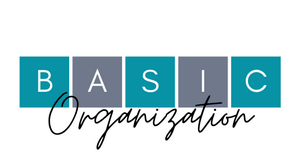6 Outrageous Organizing Strategies
Everybody likes organizing strategies that are quick and easy. BOOM! DONE! Right? Just try one of these quick and simple strategies and see what a difference it makes.
Make it easier to put things away than to take them out.
Make it simple. If something takes two steps you are half as likely to do it, as something that takes only one step. Store toys in a toy box, instead of on a shelf. Easier to just throw items in the box. Use a crock on your countertop for cooking utensils instead of having to open a drawer to store them. Create a home for your shoes at the front door where you are more likely to leave them (and find them).
Don’t buy storage containers until after you have purged.
This is a big mistake people make when they want to get organized. How do you know what to buy before you know what you are keeping? It’s so common. That’s why Target and Home Depot (and many other retailers) put plastic bins at the front of the store in January when everyone has the resolution to get organized.
Use containers as visual signals that it’s time to purge.
Storing temporary items together will show you when you have enough. The best example is magazines. Get a basket or bin to store what you’ll read and place it in your reading area. You know more will be arriving in the near future, so when the container is full, it’s time to purge. This strategy limits the amount of reading material you have without having to make decisions all the time. If you find yourself having to purge magazines all the time, then consider canceling a subscription.
Don’t have a junk drawer (or two).
Having no clearly defined purpose for any space makes it a clutter magnet. Name all your drawers with a purpose (or purposes). Call it the key and cell phone drawer, the office supply drawer, or the make-up drawer. Then use that space for only those items.
Keep a donation box in your closet.
When an item doesn’t fit anymore or is too worn out, make the decision to get rid of it right then. Placing a box in your closet for such things gives them an immediate home and when the box is full, it’s time to visit a donation drop-off site. This strategy works great in kids’ closets since they out-grow clothing so quickly.
Place your most frequently used items, front, and center.
Again, simple is best. If you touch an item every day place it in a location that is convenient. Place your less frequently used items further away from where you use them. The very top and very bottom of the kitchen cabinets should hold your less-used items. Seasonal items (holiday decor, camping gear, etc) can be stored in the attic or deep in the basement. This is will allow you to make the most used space more efficient. We call this The Target Principle.
Everybody likes organizing strategies that are quick and easy. BOOM! DONE! Share on XWhich strategies will work for you? Try one and then another. Each strategy will save you time and money.
Subscribe by email
Enter your email address to subscribe to this blog and receive notifications of new posts by email.
Janet Schiesl

Janet has been organizing since 2005. She is a Certified Professional Organizer and the owner of Basic Organization.
She loves using her background as a space planner to challenge her clients to look at their space differently. She leads the team in large projects and works one-on-one with clients to help the process move quickly and comfortably. Call her crazy, but she loves to work with paper, to purge what is not needed and to create filing systems that work for each individual client.
Janet is a Past Board Member of the National Association of Productivity and Organizing Professionals and a Past President of the Washington DC Chapter of NAPO were she has been named Organizer of the Year and Volunteer of the Year.

Janet Schiesl
Janet has been organizing since 2005. She is a Certified Professional Organizer and the owner of Basic Organization.
She loves using her background as a space planner to challenge her clients to look at their space differently. She leads the team in large projects and works one-on-one with clients to help the process move quickly and comfortably. Call her crazy, but she loves to work with paper, to purge what is not needed and to create filing systems that work for each individual client.
Janet is a Past Board Member of the National Association of Productivity and Organizing Professionals and a Past President of the Washington DC Chapter of NAPO were she has been named Organizer of the Year and Volunteer of the Year.

Don’t buy storage containers or organizing tools until you purge – 100% agree. I always recommend keeping a donation box on every level of the house as a way to get started with serious decluttering. Great post and practical tips to use today!
Thanks Amy. How many times do you visit a new client’s home and they have sooo many empty containers!
I totally agree with (and recommend) everything you’re suggesting. I especially love the “junk” drawer tip (they have a place in my heart, along with laundry rooms) – I always refer to them as “utility drawers” to give them some meaning.
As I mentioned to Janet B. I like to give each drawer a name (not junk drawer), then it has a purpose.
My favorite is use containers as a visual signal that is time to purge! When that magazine basket is overflowing – time to sort and purge! When we consider our dresser drawers as a container – when they start getting too full – time to purge.
This rule keeps you honest if followed.
Based on this, I’m not doing too badly. I have something like a junk drawer, which is part of my paper towel holder. We use it to hold small things like twist ties and a pair of scissors. The drawer is really too small to become a full-fledged junk drawer, so the risk is low of it getting out of hand.
We don’t have a junk drawer either. We do have a drawer in the kitchen that holds, car keys, my husbands wallet, pens and pencils and scissors. I think if you can name the purpose for the drawer than it’s not a junk drawer.
My favorite is leaving shoes by the door. It encourages clean floors since you won’t be tracking in dust from the street and the shoes will be there for you when you’re ready to leave the house.
Killing two birds with one stone Diane!
With several visual people in my home, keeping the most used items front and center are critical. However, we do revise the items that need to be front and center every six months. Thanks for sharing. I’m definitely sharing this one.
Thanks Sabrina. Keeping your most used item close saves so much time, but there is definitely a tipping point when you have too many, so a six-month review is a good idea.
These are all great, and I live (and advise clients) using most of them. I must repeat the “don’t buy containers — even (or especially) celebrity-branded ones — until you purge” a dozen times a week. Personally, I take off my shoes when I enter, and while I don’t keep them by the door, I do make sure they go where they make sense to me. The smartest, niftiest of your tips is letting the containers decide when you’ve reached the tipping point for purging!
So often prospective clients ask what they should buy before we even meet. We all hope to educated that the purchasing step is later in the process.
These are wonderful solid strategies. The one about buying organizing products in advance of editing comes up frequently. In many cases, my clients have collected quite a wide assortment of organizing products over the years but aren’t necessarily using them to their advantage. So in most situations, I like to do the editing and then “shop” at home first. If specific things would help after we’ve gone that route, we add them to the list. In other circumstances, the clients want all new and matching products. But again, until we know what’s needed, it usually helps to wait until the edit is done.
I completely agree Linda. Most people jump to this step before it’s time. We can usually make what they have work.
Unfortunately our “shoes by the front door” strategy didn’t work out too well – it was a giant jumble, and, we often enter the house through the garage. Problem solved: Purchased a shoe rack for the garage! Once it finally occurred to us to do so, it was easy; we’d had trouble agreeing on what a shoe rack near the front door should look like. But any old shoe rack that was big enough is just fine for the garage!
Glad you figured out a strategy that worked for your family. That’s great.
I love these ideas because, although simple, they create a burst of satisfaction when implemented. I think purging is a huge one because most people get used to seeing the same items in their home and don’t question whether or not it belongs there (hello, friend!).
Hi Jill. I agree. Clutter can become “wallpaper” or “decor” and people just don’t see if anymore. Taking a photo of a space or looking through a cardboard paper towel ring changes perspective and you see the clutter again.